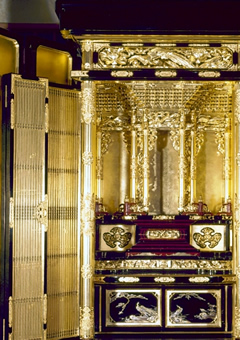KAWANABE Butsudan (Household Buddhist Altars)

At the beginning of the Kamakura era (1185-1333), the Kawanabe area was known for its devotion to Buddhism. This started when the influential Kawanabe family, who controlled the southern part of what is now Kagoshima Prefecture, together with the last of the Heike family, who had been defeated at Dannoura, began holding memorial services and preaching the word of the Buddha along the clear waters running through the nearby ravine. Many of the monuments, tombs and Sanscrit engravings ascribed to them still remain on the 500-meter-high wall of rock there.
In 1200, a temple dedicated to the supreme enlightenment of Kawanabe was built, further increasing the popularity of Buddhism in the area. It is thought that the skills and techniques used in the making of Kawanabe household altars developed as a result of these events.
Each Kawanabe household altar is the work of seven different artisans specializing in building the base, constructing the inner sanctuary, carving various decorations, fashioning the fittings, applying the lacquer coating, applying the maki-e gold- and silver-sprinkled lacquer, and finishing. These expertly crafted altars are durable and reasonably priced.
Feature
Kawanabe household altars are produced by artisans specializing in seven areas, including crafting the wooden base, constructing the inner palace (kuden), sculpting the decorations, fashioning the metal fittings, applying the lacquer work, painting the maki-e designs and finishing. Their respective techniques combine to create an exquisite and robust altar at an affordable reasonable price.
How to make
The base is created from cedar or pine wood, among others. The base is painted black with natural lacquer and finished with pure gold leaf and gold-sprinkled lacquer. Next, the inner palace is constructed, the decorations are sculpted, and the metal fittings are fashioned. Finally, the individual pieces are assembled to produce the finished altar.

